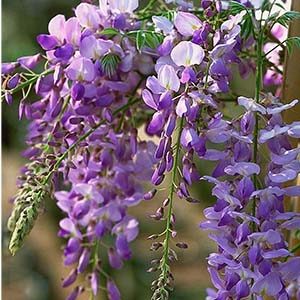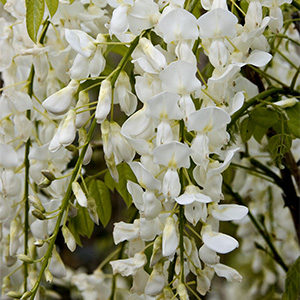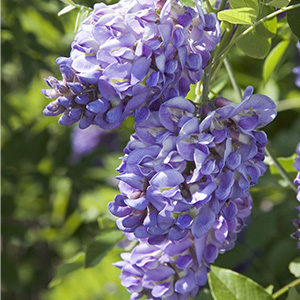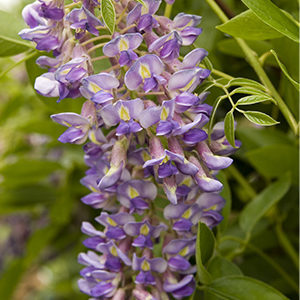Here are a few really spectacular varieties from which to choose, each with huge, cascading flower clusters. If you’re not sure which one would work best for your particular conditions, ask in the comment section. Or, better yet, consult with your local garden center (find one close to you right here.)
Pink Japanese Wisteria
What: Masses of fragrant, rose-pink flowers hang in long, dangling racemes that shift gently with every breeze. Zone: 5 – 9
When: Early Spring
Best Feature: It’s all about romantic color.

Texas Purple Japanese Wisteria
What: Spectacular pendulous clusters of sweetly fragrant flowers. Zone: 5 – 9
When: Spring
Best Feature: Blooms at a very early age.

Iko Yama Fuji Silky Wisteria
What: Lovely, long racemes are covered with rich violet buds that open to highly fragrant, pale lilac blooms. Zone: 5 – 10
When: Spring
Best Feature: A profuse bloomer.

White Japanese Wisteria
What: Huge nodding clusters of very fragrant pure-white flowers. Zone: 5 – 9
When: Spring
Best Feature: Attracts butterflies in droves.

Amethyst Falls American Wisteria
What: Lush with intensely-purple blooms. Zone: 5 – 9
When: Spring
Best Feature: Compact, perfect for small spaces & large containers.

Blue Moon Kentucky Wisteria
What: Sets lavender-blue blooms up to three times in a season. Zone: 4 – 9
When: Late spring
Best Feature: Among the hardiest wisterias.

Shiro-Beni Silky Wisteria
What: A profuse bloomer with 4 to 6 inch long racemes of pink flowers. Zone: 5 – 10
When: Late spring
Best Feature: Dark pink buds and light pink flowers grace the clusters at the same time for a two-toned look.
Keeping Wisteria Happy: If you have plenty of sun, lots of room, sharp pruners, and a very sturdy support, wisteria is not a difficult plant to grow.
- Grafted plants (which we offer) are more likely to ensure blooms within the first three years.
- Provide heavy-duty support such as a sturdy trellis or arbor.
- Six hours of full, direct sun will yield best bloom.
- Provide good drainage and a slightly alkaline soil.
- Protect from strong winds which can damage flower buds.
- Give it plenty of water when in bloom.
- Avoid feeding with high-nitrogen fertilizer as this is likely to produce plenty of leaves, but fewer flowers.
- Wisteria can live a long, healthy life with no pruning at all, happily twining, climbing, and sprawling. To control size, prune in winter, and if desired, again in summer.





Please login to comment.
Don't have an account?
Sign Up for free